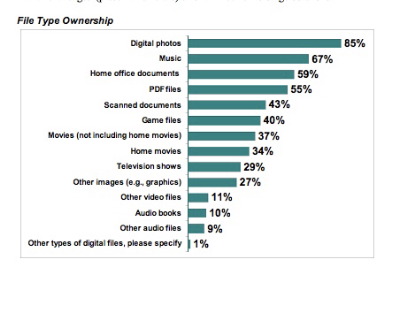
Storage matters. Taking into account that nearly 80 percent of U.S. households own a PC – along with the increasing ubiquity of cell phones, digital cameras and MP3 players – it would seem consumers are swimming in a sea of digital content.
Today, the average online adult owns nearly 1,800 digital files, with an increase of 1,000 per user expected next year. In light of this explosion of content, how consumers store their digital files grows more important each day. The typical storage device is measured in hundreds of gigabytes. This is compared with the megabytes of only a few short years ago. A PC usually comes equipped with a 250GB hard-drive, as opposed to the 100MB capacity models from the early 90s.
A crucial component of understanding consumer behavior is to ascertain whether consumers consider the protection of digital storage a priority. CEA’s new study, Amassing Digital Fortunes: A Digital Storage Study, assesses several key questions regarding the content protection:
–The types and quantities of digital files consumers are storing.
–How consumers store their files.
–The general level of satisfaction with current storage solutions?
–The present and future challenges that exist with current storage solutions?
We asked U.S. online adults about the types of files they compile for personal use. We know consumers are storing a substantial and increasing amount of content on a variety of devices. In addition, we know much of this has significant personal value. As the chart illustrates, digital photos and music are the most common file types.
One need only consider the case of digital music to appreciate the sophistication of available storage potential. A person can build a library of almost 40,000 songs (akin to 3,000 CDs) on a single, portable device. Digital cameras and cell phones are becoming more commonly utilized for storage of files as well. Nevertheless, the overwhelming majority of storage activity occurs in the home. That is where 96% of online adults access content from their PC.
Surprisingly, CEA finds a high degree of complacency regarding existing storage mechanisms. In fact, many consumers opt not to back up their files at all. This ambivalence is most likely attributed to a lack of awareness of available options, combined with concerns involving ease of use. Despite the possibility of hard-drive failures or damaged back-up discs, the possibility of file loss still does not resonate with the majority of consumers. Simply put, many users have revealed that backing up their files is not a high priority.
Educate Consumers on the Need for Storage Solutions
In order to foster demand for affordable and effective digital storage solutions, an effort to educate and alert consumers is needed. First and foremost, owners must be cognizant of the importance associated with the content they may not be backing up. Photos, in particular, may hold the highest value, yet often constitute the highest risk for loss if not properly backed up. Once people properly assess how much personal worth their files contain, it is critical they be made aware of the options available, and the relative simplicity with which they can be used.
For those already attentive to the risks involved, it remains imperative that they understand how to perform, complete and frequent back-ups. While blank discs remain, by far, the most popular method of storage, these may not be the most effective, and consumers are likely to invest in more reliable options if they fully appreciate what is at stake. As always, appropriate targeting and messaging will determine the successful attraction of this considerable demographic. ce.org





